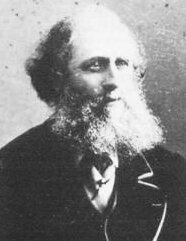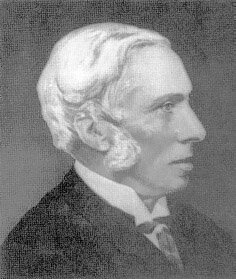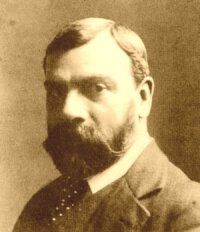
A Short History of Bedford Park
Long considered a prototype for later garden cities and suburbs, Bedford Park owes its origin to the Aesthetic Movement of the 1870s. This followed the ideals of men such as John Ruskin and William Morris, who encouraged the appreciation of beauty in everyday life as a revolt against what they saw as mid-Victorian materialism, ostentation, vulgarity and the increasing effects of industrialisation. In a letter written in 1874 Morris said: '...suppose people lived in little communities among gardens and fields, so that they could be in the country in five minutes.'
 Among the London middle-classes were many who looked in vain for a suitable environment in which these ideals could be expressed. Their need was recognised by Jonathan Carr, a cloth merchant with a taste for property speculation and family connections in the world of art.
Among the London middle-classes were many who looked in vain for a suitable environment in which these ideals could be expressed. Their need was recognised by Jonathan Carr, a cloth merchant with a taste for property speculation and family connections in the world of art.
Having married the daughter of a man who owned quite a bit of land round Turnham Green station on the western edge of London, in 1875 he bought 24 acres and set about his scheme. The site was ideal, with many fine trees, and with connections to all parts of London and the City only 30 minutes away. Carr planned a new kind of estate in which aesthetically acceptable houses at cheap rents would be set in an informal layout which preserved as many mature trees as possible.
Architecturally, Bedford Park can be seen as the embodiment of the newly-fashionable Queen Anne Revival style of the 1860s. This was a somewhat inaccurate term describing a combination of 17th and 18th century English and Flemish domestic design which also incorporated eclectic motifs drawn from many sources. This included rubbed-brick arches and dressings over and around openings, terracotta embellishments, open-bed and broken pediments, monumental chimneys, shaped and Dutch gables, tile-hung gabled walls, white painted balustrades, balconies and bay-windows. Unlike many contemporary houses, there were no basements and front gardens had wooden fences rather than iron railings.
Bedford Park’s buildings and community spirit were an inspiration and model for the creators of later garden suburbs and cities. It may have lacked their planned social structure, but Carr provided a church, adjoining parish hall, stores, a pub called The Tabard (in contrast, the founders of Hampstead built tea rooms as they disapproved of alcohol), not to mention a Club with a stage for theatricals and where the progressive residents even allowed ladies to join in debates – not exactly the usual Victorian behaviour.
Judging from contemporary accounts, there were also frequent fancy dress balls and ladies cycled around in bloomers. Early residents included painters and illustrators – quite a few houses had studios – writers, actors, poets (the Yeats family rented various houses over the years), general free-thinkers and even the odd Russian anarchist.
By the end of the Second World War, however, Bedford Park’s glory days were over. Many of the houses were in multi-occupation, the old club house was a club for CAV workers, and bus conductors called it “poverty park” when Tom and Eleanor Greeves moved here in the 1950s. Both were architects who appreciated the spacious houses, and when demolition threatened some of these Tom co-founded the Bedford Park Society in 1963 to protect the amenities of the earliest garden suburb.
The building of Bedford Park can be divided into four phases.
Phase I 1875–1876
The key to success for Jonathan Carr’s novel suburb lay in establishing the reputation of Bedford Park in the minds of the artistic community at large.
As his first architect, Edward William Godwin had the required credentials, having designed houses for Oscar Wilde and James McNeil Whistler in Chelsea, establishing himself as one of the leaders in the Aesthetic Movement.
Carr commissioned designs from Godwin and the firm of Coe and Robinson. The former provided designs for two houses, one detached and one semi detached, while the latter drew up one semi-detached design. As was to be his way with all his architects, Carr bought the designs outright, and retained control over where and how they were built with limited further input from the original creator.
When these first house designs were published in the architectural press they attracted severe criticism for perceived defects in their internal planning. To be fair, one of the correspondents admitted that this at least recognised that they were worthy of critical appraisal, but Carr was not going to live with adverse publicity, which he could ill afford so early in his enterprise. He therefore parted company with both Godwin and Coe and Robinson and had his surveyor/architect William Wilson adapt Godwin's detached design.
Carr then turned to a leading architect of the time, Richard Norman Shaw, for further designs
Phase II 1877-1879
 Shaw's first designs for Bedford Park were produced in 1877, and were built next to Godwin's houses at the bottom of The Avenue. Carr was delighted with them (and with the reception they received in the press), so he commissioned from Shaw a further range of different designs.
Shaw's first designs for Bedford Park were produced in 1877, and were built next to Godwin's houses at the bottom of The Avenue. Carr was delighted with them (and with the reception they received in the press), so he commissioned from Shaw a further range of different designs.
It was these which established the architectural character of Bedford Park that we now recognise today, and which were so influential by their sheer novelty. Shaw presented drawings of imaginary streetscapes composed of his different designs, with the boundary fences, piers and other peripheral features that are now so familiar to us, and the images he produced then are a remarkably accurate prediction of what was eventually built.
As with Godwin, Carr bought designs outright from Shaw, who had no role in planning the estate, nor in deciding which houses should be built where or, indeed, in the supervision of construction. What was and is important was the result, not the process, and this boils down to the elusive concept of character. The essential ingredients were the ad hoc nature of the planning, which successfully copied the organic growth of a village, the retention of mature trees, and the architecture itself, using materials that gave the place an established look in a short period of time.
During this phase of the development Wilson is credited with a number of detached cottages, while Maurice B Adams designed the Club House and the extension to St Michael's church.
The design for the palisade fence and boundary piers is first seen in Adams’s 1877 advertisement for Bedford Park. This showed an ideal street, with houses by Norman Shaw, drawn from one of his sketches. This type of fence only seems to have been used for some houses in The Avenue, Blenheim Road, Woodstock Road, Bath Road, Queen Anne's Grove and Marlborough Crescent. The remains of a low brick wall with gaps for the posts often indicate its former presence.
Phase III 1880 - 1886
 By the early 1880s the heart of Bedford Park was complete, but Carr had steadily acquired more land, and was still building. The development now entered a final and distinctly different phase, prompted by the resignation of Shaw as the estate architect, and the refinancing of the enterprise as a Limited Liability Company. It would also appear that at about this time William Wilson left the project.
By the early 1880s the heart of Bedford Park was complete, but Carr had steadily acquired more land, and was still building. The development now entered a final and distinctly different phase, prompted by the resignation of Shaw as the estate architect, and the refinancing of the enterprise as a Limited Liability Company. It would also appear that at about this time William Wilson left the project.
Shaw had wearied of Carr's demands and, it is said, of his reluctance to settle his bills. However in resigning he set up the succession of his pupil and protege Edward J May, who was about to set up in practice on his own. The architectural progression from Shaw to May is almost seamless: May worked on Shaw's designs, and Shaw probably looked over his shoulder when he was operating independently. The essential style did not change at all. The houses in Priory Gardens date from this handover period, and stylistically could be from the hand of either.
Notwithstanding this, there is increasingly a distinct difference in the character of the streets developed in the 1880s. The changing emphasis of the development, now nominally the Bedford Park Company Ltd (but in reality still Carr), and perhaps a changing market, led to the laying out of larger plots. On these were built larger houses and, most important of all, a higher proportion of individual houses for individual purchasers. The most striking example of this is in The Orchard, where most – although not all – the houses are one-offs, designed largely by May, on plots up to four times the size of those in Woodstock Road built a few years earlier. For this reason it is arguable that May had also taken over the responsibilities of siting and the overall planning of the project.
Jonathan Carr's greater scheme for Bedford Park, which by that time included a proposed westward extension to be designed by E J May, was unfortunately brought to an abrupt end in 1886, owing to the failure of the company which had been formed in 1881 to finance the project. An area comprising about half the land that had been acquired is shown on Adams's map drawn in 1931, which contains the original core of houses now listed.
Phase IV 1887–1914
This turned out to be the end of Bedford Park’s distinctive design in both houses and layout. Under Jonathan Carr's control there had been a definite feel of unity in style and purpose, along with the growth of a fairly small community.
As the estate expanded, construction proceeded on the remainder of the land, now sold on to various other developers. Although they built similar houses, they did not use previous architect designs, so there is a different feel to these streets.
There are, however, many interesting houses in the later part, notably 14 South Parade designed by Charles Francis Annesley Francis Voysey in 1891.
The inheritance
Bedford Park pioneered a number of concepts later used and formalised by the designers of the garden city movement. It is the result rather than the process that sets the area apart, and makes it an important landmark in suburban planning.
Carr's instincts led him to create what greater intellects could later explain and emulate; yet it is arguable that we have here a more successfully semi-rural environment than Bedford Park’s more carefully planned successors. Britain in the first half of the 20th century developed a form of suburbia that is unlike anything else in the world, and this estate represents a turning point in the architecture and layout adopted for it. Without the intellectual framework of garden city pioneer Ebenezer Howard and the socialist influence of William Morris, it is perhaps all the more remarkable that one man should have created such a place, and such an influential social experiment. It is not diminished by the fact that Carr was a slightly dubious property developer, nor the decline of his business through his less shrewd ventures. He was treading new territory, and it is right that he should be remembered for it
Though now swallowed up by Greater London, Bedford Park still retains its identity, community spirit and the unique character bequeathed by Carr's inspiration and Shaw's genius.